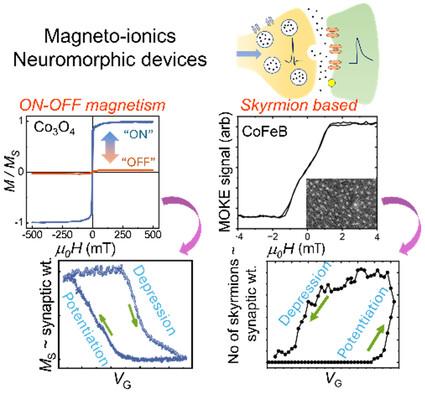用于突触设备和神经形态计算的磁场学:最新进展、挑战和未来展望
IF 11.1
Q1 MATERIALS SCIENCE, MULTIDISCIPLINARY
引用次数: 0
摘要
随着大数据时代的到来,传统的数字计算难以应对与数据分类或模式识别相关的复杂任务。为了缓解这一限制,人们实施了基于软件的神经网络,但这些网络是在传统计算机中运行的,而传统计算机的运行原理(内存和数据处理单元分离)与人脑相比效率极低。受大脑启发的内存计算可通过多种方法实现,例如人工突触、尖峰神经网络或水库计算。然而,这些方法大多使用电流操作的材料(如忆阻器阵列、自旋电子学、相变存储器),会产生显著的焦耳热效应。最近,通过电压驱动的离子运动(即磁电子学)来调节磁特性,已成为模拟生物突触功能的另一种节能方法:电位增强/抑制、多级存储或从短期可塑性到长期可塑性的过渡。从这一角度出发,我们对神经形态应用中的磁电子学进行了评论,重点是通过以下方式调节突触重量:1)通过电压诱导离子回收/插入来控制磁化;2)在固态离子超级电容器附近的门控磁性薄膜中控制磁条畴和天幕。本文介绍了这一新兴研究领域的潜在前景,并对未来的机遇进行了前瞻性讨论。本文章由计算机程序翻译,如有差异,请以英文原文为准。

Magnetoionics for Synaptic Devices and Neuromorphic Computing: Recent Advances, Challenges, and Future Perspectives
With the advent of Big Data, traditional digital computing is struggling to cope with intricate tasks related to data classification or pattern recognition. To mitigate this limitation, software-based neural networks are implemented, but they are run in conventional computers whose operation principle (with separate memory and data-processing units) is highly inefficient compared to the human brain. Brain-inspired in-memory computing is achieved through a wide variety of methods, for example, artificial synapses, spiking neural networks, or reservoir computing. However, most of these methods use materials (e.g., memristor arrays, spintronics, phase change memories) operated with electric currents, resulting in significant Joule heating effect. Tuning magnetic properties by voltage-driven ion motion (i.e., magnetoionics) has recently emerged as an alternative energy-efficient approach to emulate functionalities of biological synapses: potentiation/depression, multilevel storage, or transitions from short-term to long-term plasticity. In this perspective, the use of magnetoionics in neuromorphic applications is critically reviewed, with emphasis on modulating synaptic weight through: 1) control of magnetization by voltage-induced ion retrieval/insertion; and 2) control of magnetic stripe domains and skyrmions in gated magnetic thin films adjacent to solid-state ionic supercapacitors. The potential prospects in this emerging research area together with a forward-looking discussion on future opportunities are provided.
求助全文
通过发布文献求助,成功后即可免费获取论文全文。
去求助
来源期刊
CiteScore
14.00
自引率
2.40%
发文量
0
期刊介绍:
Small Science is a premium multidisciplinary open access journal dedicated to publishing impactful research from all areas of nanoscience and nanotechnology. It features interdisciplinary original research and focused review articles on relevant topics. The journal covers design, characterization, mechanism, technology, and application of micro-/nanoscale structures and systems in various fields including physics, chemistry, materials science, engineering, environmental science, life science, biology, and medicine. It welcomes innovative interdisciplinary research and its readership includes professionals from academia and industry in fields such as chemistry, physics, materials science, biology, engineering, and environmental and analytical science. Small Science is indexed and abstracted in CAS, DOAJ, Clarivate Analytics, ProQuest Central, Publicly Available Content Database, Science Database, SCOPUS, and Web of Science.

 求助内容:
求助内容: 应助结果提醒方式:
应助结果提醒方式:


